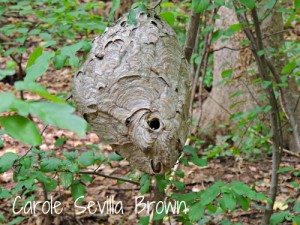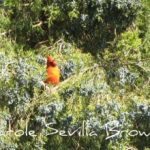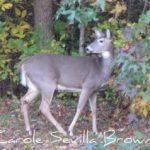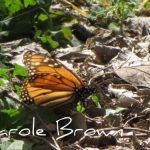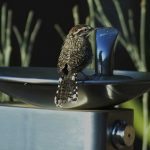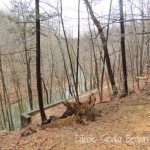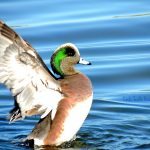I just love looking for inspiration for my wildlife garden while walking with my two Plott Hounds in the woods nearby. And recently I came across something really exciting — a Bald-faced Hornet nest. Fortunately, Otis and Morgan are used to me stopping frequently in the woods to photograph flowers, insects, birds, and other natural wonders, and they lay down quietly at my feet while I took photo after photo of this fanstastical nest.
Bald-faced Hornets (Dolichovespula maculata) are not really hornets at all, but members of a genus of wasps called yellow jackets, but since their coloration is black and white, they are not commonly called yellow jackets.
Each spring a fertilized Bald-faced Hornet female who has spent the winter protected in a tree crevice, rock pile, or maybe in the walls of buildings, will emerge and start building her nest. She does this by chewing up strips of wood, which mixes with her sticky saliva and she takes this paste of cellulose to construct her papery nest.
Bald-faced hornets, also known as white-faced hornets, are a type of wasp that are native to North America. They’re called “bald-faced” because of their distinctive white and black markings on their faces, and they’re known for their large, grayish-white paper nests that are often found in trees or on the sides of buildings.
While bald-faced hornets can look intimidating, they’re actually not aggressive unless they feel threatened. They’re primarily interested in gathering food for their colony, and they mostly feed on other insects and spiders. In fact, they’re actually considered beneficial insects because they help to control other insect populations.
One of the most interesting things about bald-faced hornets is their social structure. They live in large, complex colonies that can have hundreds of members, and they have a strict hierarchy with a queen and several workers. The workers take care of the colony, feed the young, and defend the nest, while the queen focuses on laying eggs.
If you happen to come across a bald-faced hornet nest, it’s best to leave it alone. The hornets will defend their nest if they feel threatened, and they can sting repeatedly. However, if the nest is not in a location where it poses a threat to people or pets, it’s best to leave it be and let the hornets go about their business. Bald-faced hornets are fascinating insects that are an important part of the ecosystem.
More From Ecosystem Gardening:
Submit your review | |

